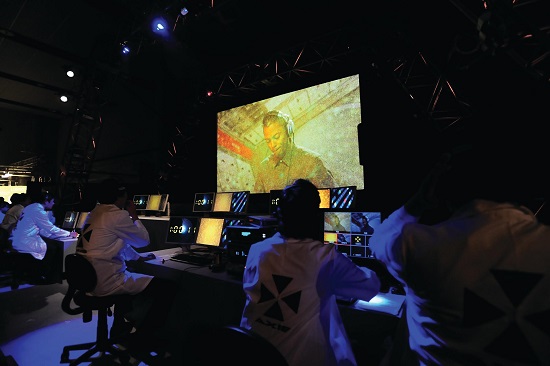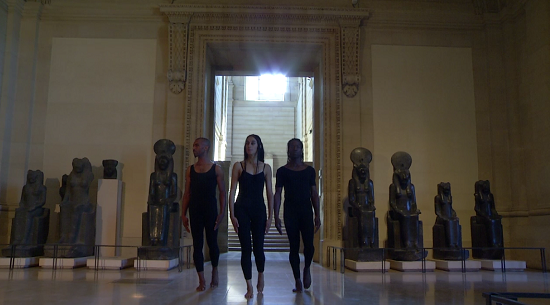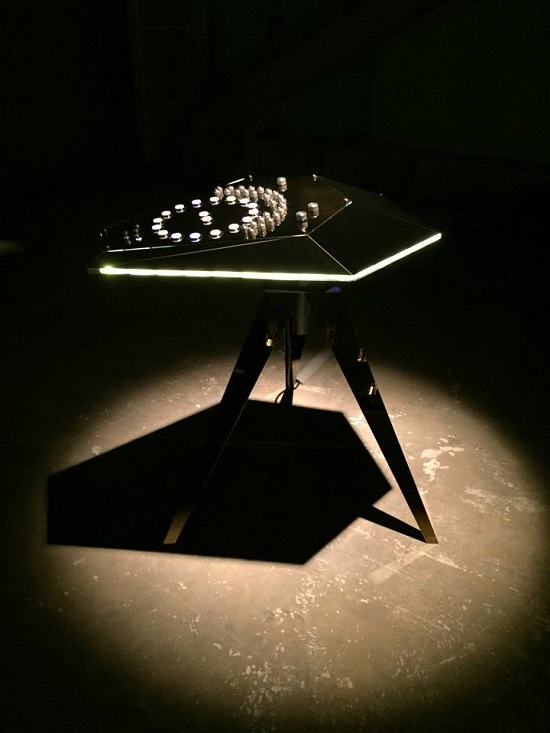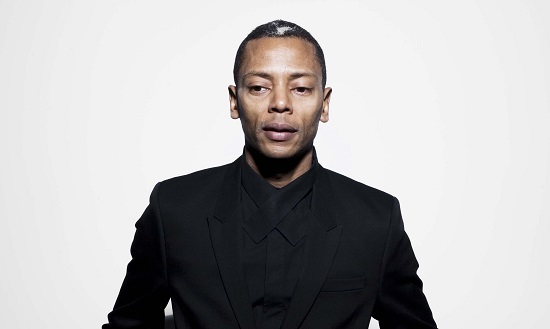Jeff Mills has spent the past 30 years living in the future. In his ongoing adventures as musician, DJ and filmmaker he combines the gleaming optimism of Golden Age science fiction with the protean tumult of the warehouse party. He is forever hurtling forward, an innovator inhabiting a space-time continuum of his own imagining.
Mills was one of the primary instigators of Detroit techno (he was born in the rustbelt metropolis in 1963). He established the avowedly nonconformist Underground Resistance collective with fellow mould-breaker "Mad" Mike Banks and, under his alter-ego The Wizard (now retired), laid down many of the founding principles of a movement that gene-spliced Kraftwerk’s digital utopianism and the hedonistic clamour of the early house scene.
But he always approached genre as jumping off point rather than destination. Stepping beyond the recognised borders of contemporary electronic music, he has set course for dimensions eerie and otherworldly, with projects that straddle experimentation and entertainment, escapism and politics
Mills has, along the way, turned his life into a lesson in the art of the possible. He divides his time between his native American Midwest and Continental Europe, where his cosmic crossover has found its most enthusiastic audience. Mills is surely the only performer alive who has received the Ordre des Arts et des Lettres from the French Ministry of Culture and be named-dropped in an Eminem song (‘Groundhog Day’ from 2013’s The Marshall Mathers LP 2). His next undertaking is a live "cine-mix" soundtracking of the 1929 Fritz Lang classic Woman in the Moon, to be staged at London’s Coronet Theatre on Thursday April 28.
Swapping the dance-floor for deep space: X-102 Discovers The Rings Of Saturn (1992)
A highly regarded techno album inspired by the Cassini-Huygens space probe
Jeff Mills: We didn’t have the internet in Detroit in the early 90s. To research Saturn, I went to the main library and got as many books as I could. I read and read so that I could at least understand the main aspects of the planet. I took the information back to the other guys I was working with: Mike [Banks] and Robert Hood [third founding member of Underground Resistance] and outlined my vision for the project. We made the album and subsequently a film. It was a tutorial trip to the planet, over the rings and the surface, then to the moon Titan.
Setting course for far off galaxies: The Occurrence (2010)
A limited edition Japanese ‘vinyl on one side and CD on the other’ hybrid album
JM: I’ve always loved science fiction. What’s great about it is that you can present interesting concepts in unique ways. The album told the story of a fictional "occurrence". An astronaut is returning to Earth from the edge of a Spiral galaxy. During a space walk he is caught in a radiation storm and narrowly escapes. When he gets back to Earth, it is the basis of another record, The Messenger. It is a project of albums each based on a chapter of the story. There was also One Man Spaceship, Jungle Planet and so on. I’m on the ninth chapter now, Free Fall Galaxy.
Beaming himself through the stratosphere: Sleeper Wakes at Wire

A live simulcast with Mills DJing in Chicago to the Wire club in Yokohama
JM: This was a live simulcast from Chicago to Japan – a live feed to a festival. It was a very expensive project – probably THE most expensive. It was a sign of things to come I think. As time goes on, performers may physically not be present in the rooms they are playing. They will be able to send a transmission to an audience far away. Perhaps that will become more normal as things advance. I was in a film studio in Chicago, on a set that resembled a space-craft. The scenario was that I was in space searching for new ideas to bring back to Earth. I was on this occasion sending back information in the form of music.
Consummating a love affair with Europe: Etudes Sur Paris (2012)
Live film rescore for French film festival
JM: For close to 18 years I’ve spent about half of each year in Europe. Most of the time in Berlin but then Paris. I had just moved to the city [in 2012] when I was asked to re-score André Sauvage’s film for Paris Film Festival. It came out so well we decided to release it as a soundtrack. It was the first project I did here. I was new to Paris, just becoming familiar with the city. My perspective was that of someone looking in from the outside, which was very much reflected in the music.
Exploring the possibilities of film and dance: Life To Death and Back (2015)

Film scored, written and directed by auteur, Mills
JM: One of my favourite projects. It is a film made with a team of three dancers in the exhibition space at the Louvre. I was trying to show how Egyptians looked at the world: their belief that life was one stage of this ever ongoing loop and how the Pharaohs would descend from the heavens, walk the earth and, almost from the beginning, plan to die – so that they could be reborn in another form. It was fun to research. I worked with the Louvre and came up with the idea of using the staircases to present the Pharaohs as coming from the heavens, descending the steps to the main floor and stepping through the exhibition. This was symbolic of them walking through life. Then they went down another staircase, symbolising their walk into death.
Taking the audience on a temporal trip: Time Tunnel (2014)
Concept heavy club night at various European clubs
JM: This was an excuse to programme lots of different types of music for an audience. I needed a concept that would allow me incorporate many styles in one evening. I came up with the format of the TV show from 1965. Every 16 minus the audience is introduced to a different place in time and space. We "travel" there through the tunnel. Then, after another 16 minutes, we would arrive at another completely different time and space. It could be from the past or very far in the future. I would choose seven distinct eras, from tribal, to jazz, the 50s, country, hip hop, classical, Debussy.
The last one was in Amsterdam with the theme of science fiction. We explored Close Encounters Of The Third Kind and various other science fiction pieces. We used actors and props to play out each segment. I’m not sure if everyone really understood what was going on as it was a very large audience.
Going the full Kubrick: 2001: The Midnight Zone (2015)

Multi-media dance, music, cinema, parallel retelling of 2001: A Space Odyssey
JM: I was asked to create a contemporary dance piece for the Philharmonie de Paris last year. I wanted to do 2001: A Space Odyssey. The rights are so restricted there was no way I could work with the film. Instead I created a parallel story that takes place in the year 2000 but in the deep ocean of Earth rather than space. There we find a race of people who were connected to the Ancient Egyptians and somehow to the civilisation of Atlantis. They were put there, in the ocean, because the time would come when the universe and the cosmos would realign.
The year 2001 comes along and that is what happened. The difference is that, unlike the characters in 2001, these creatures in the ocean are very much connected to what is going on and had prepared for it. Each segment gets closer to the moment we recognise from Kubrick’s film – that journey into the infinite. At a certain point the dancers go away and the film takes over and the audience is taken on this very abstract journey through the same iconic sequences that ended 2001. We do a set change arrive in this room. There is one dancer and we play out the conclusion to 2001. It was a lot of fun – you had to consider costumes, choreography, soundtrack, the film… it was a big job. Unfortunately we only did it once.
Exploring The Cosmos: The Planets (2015)
JM: I had always been a fan of Gustov Holst’s The Planets, which debuted nearly 100 years ago. I wanted to deliver a more modern piece about the Solar System. The idea was to present a tutorial of each planet. We used a lot of modern discoveries, by NASA and the other space agencies. Holst brought a Greek mythological perspective to what he was doing. My version, which we premiered in Oporto, was more about space science. It addresses the geography of each planet: the diameter, the mass, the density, whether they had rain-fall.
Boldly going where no DJ has gone before: Weapons (2015)

An exhibition of music-related artefacts at Terada Warehouse, Tokyo
JM: This was a walk-in exhibition incorporating art and sound [held at the Terrada Premium warehouse in Tokyo]. I am an enthusiast of UFO-logy. There was one incident I got stuck on and began to research. The sighting occurred 1942 in California and would become known as the Battle Of Los Angeles. This was during the war, two months after Pearl Harbor and following the bombing of an oil field near San Francisco by a Japanese submarine. The US army had moved its artillery to the west coast. They expected an invasion.
One night, a number of objects were seen in the sky approaching the coastline. For over an hour, the US military fired at them. These things eventually flew down to San Diego – a huge number of people saw them flying close to shore. Everyone thought the Japanese were coming. The next morning they had vanished, leaving no trace. But the US army decided it could not trust Japanese-Americans any more. They were rounded up and put in concentration camps in the desert.
Weapons was inspired by that incident. It is about how a weapon can be more than a gun or a bomb – it can be propaganda, manipulation of press, using cinema to brainwash. Weapons is about how the public can be swayed into believing anything. We used a lot of film noir in the exhibition. In the early 40s noir was a very underground, low budget part of Hollywood. A lot of the establishment – the government, certain politicians – were against it, because they thought it was risky and damaged the minds of young people. This was all happening in 1942, the same year as the Battle of Los Angeles.
Traveling back to the future: Woman In The Moon (2015)
Live film rescore
JM: I was asked to come up with a movie of Fritz Lang’s to re-score and I chose this. The film has a very interesting history. It was the last science fiction feature Lang made before going to America and moving into more mainstream drama. It was also very expensive and bankrupted the film company.
Woman In The Moon is an extraordinary time capsule. Lang was consulting with scientists and astrophysicists about the technology he was portraying on screen. He was getting information from people working for the German government building rockets – actual secrets that the Nazis would later capitalise on.
Those segments were subsequently censored by the Third Reich for fear there might be spies in the audience. The director truly was ahead of his time in so many ways. The movie was the first to convey an accurate impression of what a lunar surface might look like. The idea of putting a rocket on a stand and pushing it to the launch pad originated here, as did the countdown from 10 to one. The concept of the countdown was created by Fritz Lang. It’s interesting to watch this it from the other side of the Space Age, having now gone to the moon and back.
Science fiction as philosophical treatise: Free Fall Galaxy (2016/7)
Planned album
JM: This is the ninth chapter of my science fiction sequence, which has the overarching title of Sleeper Wakes. It is about a fourth kind of galaxy. It isn’t a spiral galaxy, an elliptical galaxy or an irregular galaxy, the three recognised categories of galaxy. This one acts more like a predator. It consumes. The album alludes to the notion that perhaps humans are predators are well. There has been this idea throughout history that we must kill something and eat it in order to survive. So perhaps we are connected to this predatory fourth kind of galaxy. If you consider how we have developed time – our 12 hour clock – or that we believe in the afterlife then perhaps all of that flows from us being things of matter in a fourth galaxy that is based on hunting and consuming and attacking. It is part of who we are.
Woman In The Moon is at the Coronet Theatre on Thursday this week


